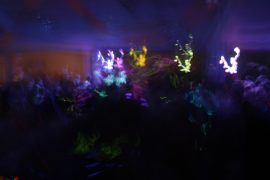Patrick Crerand
This text was set in Zukerkekshund (Condensed), a monospaced typeface once thought typical of the Dutch Golden Age, but now more commonly known as the creation of Benny “How Sweet It Ain’t” Van Tiffin (1893-1943), an American entrepreneur and portly associate of Murder Incorporated, a New York crime syndicate. Van Tiffin cast the typeface from the broken bedspring shivs at the foundry in Sing Sing Correctional Facility while he awaited his execution. Though the font family takes its form from many classic Indo-Germanic glyphs (note the influence of Cruijkshank’s Gothic Leiden on its italicized face) one can certainly see the reflection of Van Tiffin’s life in the predacious, incisor-like curves of its serifs.
The name of the font originates from the infamous sugar cookies Benny Van Tiffin roughly chewed into canine shapes and sometimes left as calling cards at the scene of hits. The story, felt to be apocryphal, comes from his childhood: Van Tiffin’s mother was deathly allergic to domestic animals and forbade him to have one, forcing Van Tiffin to make his own pet by biting a sugar cookie into the shape of a dog. The ostracizing he received from parents and peers for carrying the sugar dog (Zukerkekshund in his native tongue) and the effect of inclement weather on such a fragile confectionary delight fueled Van Tiffin’s rage as an adult and led to his eventual distaste for all things sweet in life. In his twilight years, he turned to printing threats to pastry chefs in his new font just before his sentencing (death) and eventual electrocution (smoky) in 1943.
After Van Tiffin’s electrocution, Zukerkekshund (Condensed), emancipated and adrift in New York without a patron, ran with a fast crowd and spent dark nights on prize fight posters in alleys, earning little to no money—a bitter harbinger of its life in print for the next several decades. During the haze of the Free Love Era, it took solace in the arms of Arial, became hooked on Benzedrine and found itself italicized for days, sprawled across the bellies of patchouli parlor harlots in sappy poems about the earth and harvest moon tides. A decade later you could find it in most disco era bathrooms, snorting up its dinner—its serifs long ago pawned off—anything to stay italic.
Like so many other weaker fonts of the 80s, Garamond kerned it on the subtitles of foreign skin films for less than a cent a word. While it did find a brief resurgence with the advent of computers and its rasterization in the nineties, later versions of most word-processing programs replaced it with flashier fonts like Catamaran Rounded and Informal Roman. It was not until its e turned schwa in 2000 when it finally got clean, joined a Bible-based church and became the staple font of many philological workbooks like the one you have just read.
Zukerkekshund (Condensed) currently lives in Palo Alto with Sandy, its golden retriever companion, and takes life one day at a time.
Patrick Crerand teaches fiction and nonfiction writing at Saint Leo University and also in their MA Program for Creative Writing. His work has appeared in New Ohio Review, North American Review, and other magazines. Recently Arc Pair Press released a collection of his short stories entitled The Paper Life They Lead. Find him on Twitter at @PatrickCerand.



